UPDATE June 22, 2022!!! – See post at the bottom of the page for added steps
Maybe I have bad luck. Maybe I’m not as careful as I believe I am with my equipment. Or maybe boats just continually break. Whatever it might be, the result is the same, blowing 20+ knots in an anchorage crowded with boats waiting for a coming El Norte wind I found myself without use of my starboard engine. This was learned just after dropping the hook and trying to back on the anchor.
As I added a bit of power the boat turned instead of backing straight up. After a few moments of confusion I realized what was going on, cut the power to the port engine and raised a bit of the main sail to help us drift back from the wind. We ended up closer to another boat than I would prefer but still a safe distance. Whew. I couldn’t imagine making a second attempt to anchor (I did however apologize to my neighbor for being so close, to which his response was, “Well it is always better to know the person you crash into.” Thankfully that statement was not prophetic).
The following day (after a night of 35 knot winds which shifted 180 degrees) I made a couple calls to the US, which was a shock as I didn’t think there was cell coverage in San Evaristo, but my phone dinged with a text from a friend alerting me of my good fortune. A call to PacWest for advice, their guess was it was a cable issue as the dog clutch in Yanmar SD20 sail drives rarely fail. Back on the boat I tore into the control unit and experimented with changing the adjustments and found I could get forward OR reverse but not both. A fellow cruiser stopped by and to lend a hand, it was nice to have another brain to bounce ideas off of. Ultimately we determined that there was clearly something wrong with the sail drive and since I could get the sail drive into forward decided to not disassemble anything in the anchorage.
Two days later, and after one nervous docking, I was able to disassembed the sail drive. What I found was a sheared taper pin which holds the shifter assembly to the shifter. There was also noticeable wear on the dog clutch and the shifter. Below is the disassembly process:
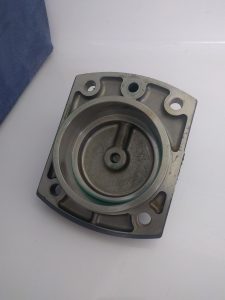
Remove the four bolts on the top of the Yanmar SD20 sail drive and then insert a bolt into the lift point to help slide the cover off

After the cover is off, the spacer is removed
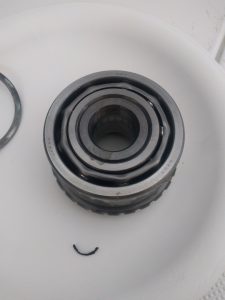
The forward gear and bearing assembly is now pulled off
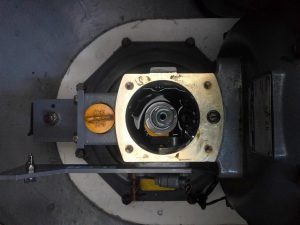
Looking down into the SD20 sail drive with the cover removed

A syringe is used to remove the sail drive oil below the shift assembly
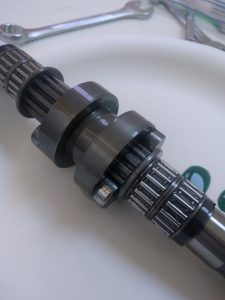
Pull up the clutch shaft (and dog clutch assembly)

With the oil and the clutch shaft removed, remove the four bolts to allow removal of the shifter assembly
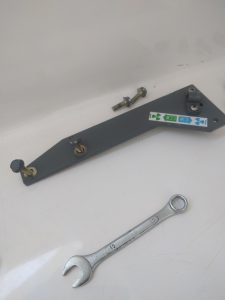
With the top two shifter assembly bolts removed the shift cable bracket is removed
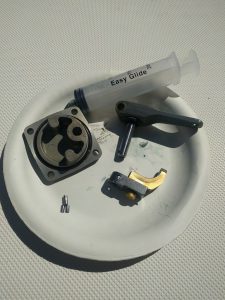
With the shifter assembly removed, the taper pin (mine is in three parts) tap out the taper pin and remove the C-clip which allows the shifter to be disconnected
I have ordered the parts that showed wear (drive gears were not replaced since there wasn’t much wear) and the O-rings. Here is the part list:
196311-06080 Shifter
196311-04310 Dog clutch
22301-040250 Taper Pin
24311-240100 O-ring
196420-12160 O-ring
24321-000750 O-ring
It was a relief finding that there was not a more serious issue, but still disconcerting to lose an engine. And yes, I did buy spare parts to do the port engine if, scratch that, when it fails.
August 3, 2018 Jamie Findlay asked a question about which direction the taper pin was installed (from the bottom, which is a bad design) and shared the following that a Yanmar distributor recommended to him:
1. Clean the hole and pin with brake cleaner
2. Apply Red Loc-tite to the pin
3. Make sure future owners know that the pin needs to be heated to 450 degrees to release the Loc-tite
June 22, 2022 Talk about a bad design…
The new owner of Strikhedonia (Allan on Fly Aweigh II) had another pin failure. However I had not known about the Red Loc-tite when I did the repair. He spoke with a Yanmar distributor who shared the information from a service bulletin (they will not distribute these for some poorly thought out decision) which provided a different procedure:
1. Clean the hole and pin with brake cleaner
2. Tap in the pin
3. Split the end with a chisel to about a 45 degree wedge – this worries me as it weakens the pin, personally I would go the Red Loc-tite route
Also learned, Yanmar recommends inspecting all of the shift/gear components every 250 hours. Sounds ridiculous but make your own decision on what inspections you deem necessary.
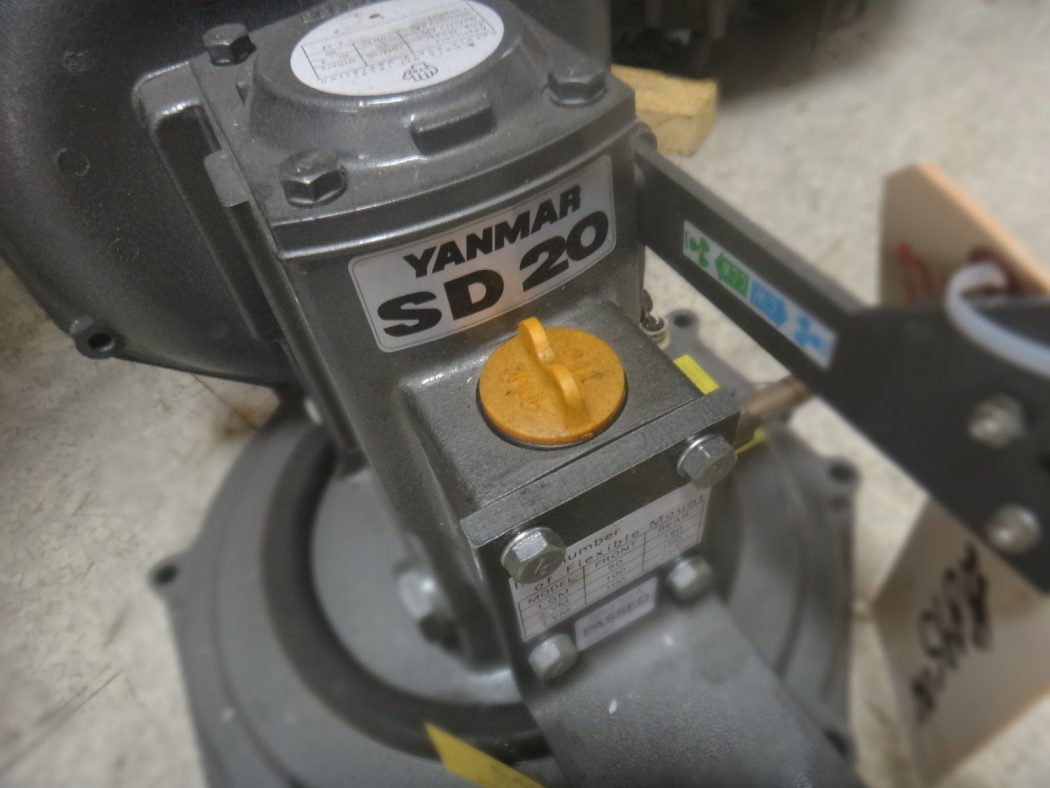
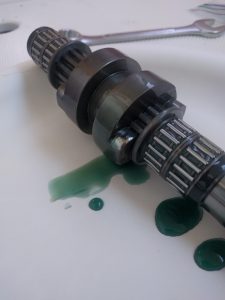
Hi, we have the same engine/saildrive in our new to us 2013 Salona 38, and when I took delivery, the engine didn’t go into reverse, on the second try it did. Same with forward gear.
Do you think this could be the dog clutch as well? I’m not sure if it’s that or the propeller bushing.
Also, is the $1,100 in parts correct? Seems WAY high?
The propeller bushing in the SD20 will NOT cause the shifting issue you describe. If the bushing fails there is a 180 degree dead stop that would engage the propeller. It is possible it is the dog clutch/shifter is the issue or it could also be your shift cable needs to be replaced. I suggest disconnecting the shift cable from the SD20 and then move the shifter to forward and reverse, checking for smooth cable movement. If that is okay, then look at the shifter assembly. To access the shifter, gears, and dog clutch remove the upper cover (P/N 196420-02152) be sure to replace the crush o-ring (P/N 24321-000750) when you reassemble everything. I think the cost was less than $200 for the parts.
This is great guidance
Hello Chris,
I have SD 20 that is hard get out of forward gear. I replaced the cable and shifter in the cockpit. I would like to inspect the shifter assembly on the right -hand side of the sail drive. Is it possible to remove the plate and shifter assembly without removing the clutch shaft?
Many thanks in advance.
Keith London
Going from memory I believe the Shifter (that moves the Dog Clutch) and the rest of the assembly can be removed without pulling the shaft. However, you will still need to drain the oil or it will make a mess when the plate is removed.
Same thing happened to both my new SD25 saildrives after only 2yrs and 1600 hours. Yanmar was not helpful. Send me an email for pics of the shifters that were almost completely worn away.
Good idea on the locktite. I will be using that recommendation as I have heard reports of the pin falling out.
Thanks for writing this post.
Lewis, major bummer on your failure. Glad I could help.
Chris, first of all, can’t thank you enough for the detailed post! On my sd20, shifting got a little sketchy to totally unreliable, and removing the cable and actuating by hand (engine running)takes large swings to get gear changes! More concerning is a clattering noise when in either gear! I’m hoping that is pieces of the pin rattling around? Did you notice any unusual noises from the drive prior to repair? Trying to decide what to order before opening her up. Thank you so much for helping! Ken Thomas
Ken, I’m glad my post was helpful. I did not hear any chattering but it could be part of the pin or it could be that the dog clutch is not fully engaging. If you have saildrive oil I’d drain it and take a look around. My parts list should give you a good starting point with what to order.
Exactly the same happened to me a couple of weeks ago, I am now waiting for the Yanmar OEM tapered pin to replace. My problem is I cannot find the broken pin, any ideas how to fish it out ? . I assume it is stainless and thus not magnetic. Can I just leave the old pin in the saildrive (hoping it made it to the bottom and resting for good), or this is just disaster waiting to happen when it gets in-between gears ?
Sorry to hear you are dealing with the same issue. I got all the pieces I could find with tweezers (after sucking out as much gear oil as was possible). There were still metal pieces that I couldn’t get out but a Yanmar dealer told me the hardened gears would not be damaged by any remaining pieces. I did drain my saildrive oil a few months later and then annually. I would say it took a couple flushes to get all the debris cleaned out.